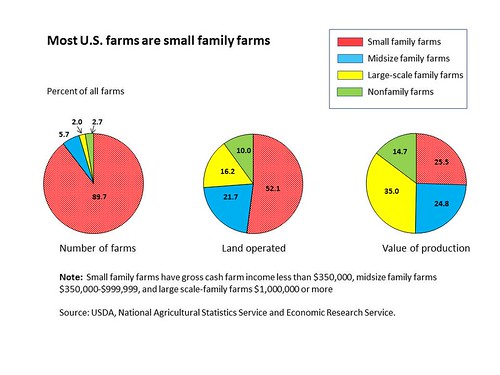
This post is part of the Science Tuesday feature series on the USDA blog. Check back each week as we showcase stories and news from USDA’s rich science and research portfolio.
Describing the structure of the U.S. farm sector is challenging, because farms vary widely in size and other characteristics. Are they largely family businesses, or corporate operations? U.S. farms range from very small retirement and residential holdings to businesses with sales in the millions of dollars. And descriptions based on U.S. averages hide much of the variation.
The Economic Research Service prepares periodic reports on family farms that provide detailed information for policy makers and others interested in farm policy and the farm sector. The reports draw on data from a scientifically designed USDA survey, the Agricultural Resource Management Survey, or ARMS. The survey, conducted annually, covers all types of farms, and is designed to accurately represent farms and farm households, including financial conditions and production practices.
The Family Farm Report, 2014 Edition provides a snapshot of farming today. When preparing reports, economists―like scientists―do a considerable amount of classifying. Perhaps most notable is that most U.S. farms—approximately 97 percent—are family farms, where the farm operator and relatives own the majority of the business. The remaining 3 percent are nonfamily, but only 17 percent of these are corporations, and all but 6 percent of these nonfamily corporations have 10 or fewer stockholders. Other types of nonfamily farms include those equally owned by unrelated business partners and those operated by a hired manager for a family of absentee owners.
The total farm count is dominated by small family farms―those with annual revenue below $350,000. Small family farms comprise 90 percent of all farms and account for 52 percent of the land operated by farms. Farms where operators report off-farm work as their main occupation account for 47 percent of small farms, which helps explain why many continue to exist even when financial performance is poor. Retired farmers still operating on a reduced scale make up another 18 percent.
Larger family farms, however―those with $350,000 or more in annual revenue―contribute the bulk (60 percent) of agricultural production, although for specific commodities the small-farm share of production is substantial. For example, small farms account for more than half of poultry production. Farms with sales of $1 million or more account for nearly half of total farm production.
The Family Farm Report classifies various types of farms by a variety of characteristics including commodity specialization, financial performance, household income, and operator age. A 12-page brochure is also available.
